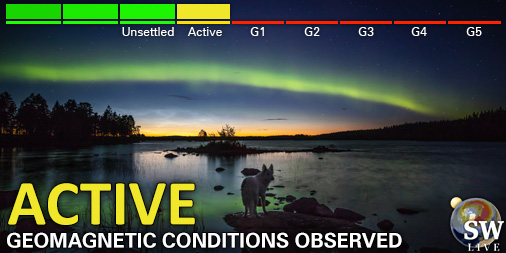Przeglądasz Archiwum z piątek, 6 kwietnia 2001
Raport aktywności słonecznej
Każdy wspomniany rozbłysk słoneczny w tym raporcie ma współczynnik skalowania dodany przez Space Weather Prediction Center (SWPC). Przez skale współczynników SWPC, raporty o rozbłyskach słonecznych są o 42% mniejsze niż naukowo jakościowa data. Skale współczynników zostały usunięte z naszych archiwów o rozbłyskach słonecznych by odzwierciedlić prawdziwe jednostki fizyczne.
Raport aktywności słoneczno- geomagnetycznej 2001 Apr 06 2200 UTCPrzygotowane przez NOAA © SWPC i przetworzone przez SpaceWeatherLive.com
Połączenie raportów USAF/NOAA o słonecznej i geofizycznej aktywności
Numer SDF 096 wydany w 2200Z na 06 Apr 2001IA. Analiza aktywności regionów słonecznych i aktywność od 05-2100Z do 06-2100Z
Solar activity has been high during the past 24 hours.
Region 9415 (S21E33) produced an X5/Sf flare at 1921Z (Please note
that the optical class could only be measured well after the x-ray
flare maximum due to weather hampering observations). Coronagraph
observations from SOHO/LASCO showed a CME associated with this event
just entering the C2 field of view at 1930Z. Region 9415 is the
dominant region on the disk with 820 millionths area in an Eko,
beta-gamma-delta configuration. The only other solar flares of note
today were a few C-class subflares. Coronagraph data also showed
that yesterday's CME, associated with the long-duration M5 event,
could be classified as a full-halo event. Nonetheless the sequence
of images give the impression that the center of the CME is not
headed directly at the Earth. Note that today's 10.7 cm flux had to
be estimated from the morning reading because intense solar radio
burst activity interfered with the normal noontime reading.
IB. Prognoza aktywności słonecznej
Solar activity is expected to be
moderate to high during the next three days. Region 9415 is clearly
the dominant region on the disk to watch for energetic flare
activity, although regions 9417 and 9418 might possibly contribute a
low-level M-class event.
IIA. Podsumowanie aktywności geofizycznej 05-2100Z do 06-2100Z
The geomagnetic field was mostly quiet to unsettled during the past
24 hours. Solar wind speeds continue to decline and solar wind
density remains low. The greater than 10 MeV proton event continued
to decline during the past 24 hours. As of 06/2100Z the fluxes were
fluctuating below and above the threshold of 10 PFU, with a reading
of 10.2 PFU at 2100Z.
IIB. Prognoza aktywności geofizycznej
The geomagnetic field is
expected to be unsettled for the next 24 hours. An increase to
active levels is expected on the second and third days as a response
to a glancing blow from the halo CME associated with yesterday's M5
flare and possible additional influence from the CME associated with
today's X5 event. There is a fair chance for an increase in the
greater than 10 MeV proton fluxes sometime in the next 24 hours in
response to today's X5 event as well, although the fluxes are likely
to increase rather gradually with peak fluxes in the low 100's of
PFU, and the spectrum will probably be relatively soft.
III. Prawdopodobieństwa zdarzenia 07 Apr do 09 Apr
| Klasa M | 80% | 80% | 80% |
| Klasa X | 25% | 25% | 25% |
| Proton | 60% | 25% | 25% |
| PCAF | yellow | ||
IV. Przepływ 10,7 cm z Penticton
Zaobserwowano 06 Apr 192 Przewidywane 07 Apr-09 Apr 200/195/190 Średnia z 90 dni 06 Apr 167
V. Indeks geomagnetyczny A
Zaobserwowano Afr/Ap 05 Apr 011/019 Szacowane Afr/Ap 06 Apr 012/015 Przewidywane Afr/Ap 07 Apr-09 Apr 012/012-025/025-025/025
VI. Prawdopodobieństwa aktywności geomagnetycznej 07 Apr do 09 Apr
| A. Średnie szerokości geograficzne | |||
|---|---|---|---|
| Aktywne | 20% | 35% | 35% |
| Słaba burza | 10% | 20% | 20% |
| Bardzo znacząca burza | 05% | 25% | 30% |
| B. Wysokie szerokości geograficzne | |||
|---|---|---|---|
| Aktywne | 25% | 40% | 40% |
| Słaba burza | 15% | 25% | 25% |
| Bardzo znacząca burza | 05% | 15% | 30% |
Wszystkie czasy w UTC
<< Idź do codziennego przeglądu
Obecnie nie ma godnej uwagi pogody kosmicznej
Najnowsze wiadomości
Najnowsze wiadomości z forum
2025/04/12-13 Filament CMEs 2025/04/16 G3 Watch 504AR4062 41Incoming & Unnumbered Active Regions 1748Ask your obscure/"stupid" space weather questions. 362AR4064 10
Więcej tematówWesprzyj SpaceWeatherLive.com!
Wielu ludzi odwiedza SpaceWeatherLive aby śledzić aktywność słoneczną lub sprawdzić czy jest szansa na zaobserwowanie zorzy polarnej. Niestety, większy ruch na stronie oznacza większe koszty utrzymania serwera. Dlatego, jeśli jesteś zadowolony ze strony SpaceWeatherLive, zachęcamy do wspierania nas finansowo. Dzięki temu będziemy mogli utrzymać naszą stronę.

Alerty
04:15 UTC - Aktywność geomagnetyczna
Aktywne warunki geomagnetyczne (Kp4) Osiągnięty próg: 03:57 UTC
02:30 UTC - Indeks mocy półkuli
Model OVATION przewiduje, że index mocy półkuli osiągnie 50GW o 03:23 UTC
środa, 16 kwietnia 2025
21:45 UTC - Aktywność geomagnetyczna
Słaba burza geomagnetyczna G1 (Kp5) osiągnięty próg: 21:36 UTC
21:00 UTC - Aktywność geomagnetyczna
Bardzo silna burza geomagnetyczna G4 (Kp8) osiągnięty próg: 20:55 UTC
19:45 UTC - Aktywność geomagnetyczna
Silna burza geomagnetyczna G3 (Kp7) Osiągnięto próg: 19:25 UTC
Fakty na temat pogody kosmicznej
| Ostatnie rozbłyski klasy X | 2025/03/28 | X1.1 |
| Ostatnie rozbłyski klasy M | 2025/04/15 | M1.2 |
| Ostatnia burza geomagnetyczna | 2025/04/16 | Kp8- (G4) |
| Dni bez plam słonecznych | |
|---|---|
| Ostatni dzień bez skazy | 2022/06/08 |
| Średnia miesięczna liczba plam słonecznych | |
|---|---|
| marca 2025 | 134.2 -20.4 |
| kwietnia 2025 | 120.5 -13.7 |
| Ostatnie 30 dni | 118.3 -22.1 |






